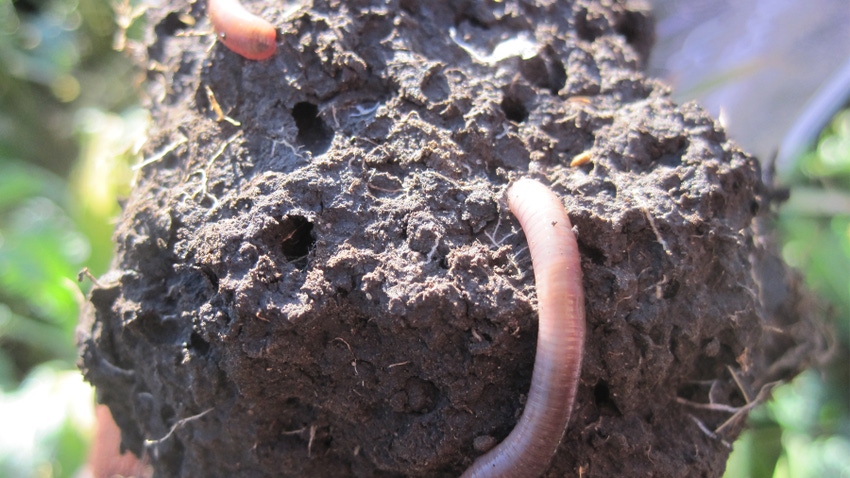
Soil health gets talked about a lot, but what does it actually mean?
“I would say soil health is kind of like human health or animal health,” Dale Strickler says. “When we talk about human health, that means we have a body that functions like it’s supposed to. Can you move around? Are you free of disease? Are you in physical shape? What’s your nutritional status? … Basically, the culmination of all those different criteria — does it work like it’s supposed to? Same way with soil health. Does the soil function like it’s supposed to?”
Strickler is an agronomist with AgSpire who lives in Wichita, Kan. He’s also a cattle rancher, as well as the author of “The Drought-Resilient Farm, Managing Pasture and The Complete Guide to Restoring Your Soil.”
Traditionally, Strickler says a common approach to modern farming has been to take soil tests and install some tile drainage, “focusing on the chemical and physical attributes of soil — and we pretty much ignored the biological aspects of soil.”
By paying attention to a soil’s biology and getting it right, Strickler says the chemistry and the physics of soil are taken care of.
Plants need four things from soil to survive and thrive: physical structure to hold the plant up; water; mineral nutrients such as nitrogen, phosphorus, potassium, sulfur, iron and zinc; and oxygen for the roots to function.
“So, you have to have gas exchange. Oxygen’s got to get in, and carbon dioxide from microbial respiration has to get out — and of course that carbon dioxide we want out of the soil, and we want it in the crop canopy for photosynthesis,” he says. Gas exchange, he explains, happens through pore space, adding that “we used to think that we created pore space through tillage; but then we find out that tillage breaks down organic matter, and that pore space that we created through tillage only lasts until the next rain or the next pass with an implement.”
Don’t ignore the little things
Allowing soil organisms to do their magic is the way to create long-term pore space, and Strickler points to earthworms and dung beetles that tunnel through soil, creating large pores. Not to be discounted are the hundreds, or even thousands, of microscopic mycorrhizal fungi that colonize on plant roots, “and the hyphae [branching filaments that make up the mycelium of a fungus] of that mycorrhizal fungi can extend up to 2 feet past the roots of the plant — and they are much smaller diameter than root hairs, so they can reach into cracks and crevices within the soil.”
These hyphae-created pore spaces are too small for plant roots to enter to be able to access mineral nutrients and water, but the hyphae do that heavy lifting. Strickler says the population of bacteria and fungi on the surface of the microbial hyphae have the strength to break down rock particles “and liberate the mineral nutrients that are inside those rock particles.”
While all this activity can happen to improve soil health, Strickler says most of today’s cropland soils lack the presence of mycorrhizal fungi, due to absence of a live root at all times. During fallow periods in a corn-soybean rotation — the seven or eight months between those crops — “the mycorrhizal fungi starve out, and that’s the first chain of an underground economy that is missing,” he says, “and without the mycorrhizal fungi, you can’t shuttle energy to those rock-digesting microbes.”
Strickler stresses that he is not anti-fertilizer; in fact, he deems it “necessary under our current state of depleted soil.” … the road to creating sufficient biological activity in the world’s cropland soils to make them so they do not require fertilizer is a long journey of unknown duration through uncharted territory. But we do have examples in nature that show us that is it possible.”
Maintaining a living root is one of the five main soil health principles, in addition to maintaining soil cover, limiting soil disturbance, providing crop diversity and integrating livestock.
All in proper context
Mark Gutierrez adds a sixth principle, and that is context. “Which is the ecological context of where you live and the weather patterns and the context of your farm and the system you have set up and the crops you maybe have historically grown — and do you have livestock, how many employees you have, all those contextual things,” he says.
When farmers follow and utilize the soil health principles “and make decisions within those guidelines, those principles can be applied and will work everywhere,” says the Gutierrez, executive director of the Minnesota Soil Health Coalition and the Minnesota Grazing Lands Conservation Association.
While Gutierrez and Strickler agree that these soil health principles can apply in any geographic area with any soil type, Gutierrez says there is no cookie-cutter approach, depending on the type of operation.
“If you try to enforce soil health as a rule, what would that look like? Well, if you’re a dairy operation that's diverse with a lot of different crops, well, that can be very different from a corn-soybean operation and how soil health gets implemented,” he says.
And that is why he sees the context principle so critical.
Gutierrez looks on his New Mexico upbringing, which was home to almost all hay, with corn and oats in rotation, and a lot of poultry. As for soil health principles, “We didn’t even know what that was. But it still is challenging to incorporate soil health practices into hay operations.”
He received a Master of Science degree in agricultural economics from New Mexico State University in 2006, and then worked as a statistician for the USDA National Agricultural Statistics Service for almost nine years before joining the USDA Risk Management Agency in the St. Paul, Minn., regional office. It is in that last position, prior to joining the MSHC and MGLCA, that he tuned into soil health and what it means.
As he admits no cookie-cutter approach suits all farming operations, he feels that all producers can implement practices to promote the capacity of the soil to function: “It’s soil that flourishes and allows the crops that grow in it to flourish as well, and it’s not nutrient-leaky.”
Added benefits
Soil health practices are proven to improve soil quality, which Gutierrez says also parlay into environmental benefits such as reduced runoff and reduced erosion, resulting in cleaner water.
“Considering those benefits, all soils could benefit from following these principles and utilizing soil health practices, because we know that we’re losing topsoil at a rate of 5.6 tons per acre, on average,” Gutierrez says. “That’s more than 10 times the level we’re replenishing it at.”
Gutierrez and Strickler agree that soil health practices can be implemented in all crop farming operations, even though there are people who argue that “no-till doesn’t work here.” “We have to till to get our soil warmed up.” “We can’t get our corn planted as early.”
Strickler responds that those farmers should look at shorter-maturity corn, or “maybe this is sacrilege — maybe you shouldn’t be growing corn. Maybe that’s a crop not really suited for your area.”
About the Author(s)
You May Also Like






